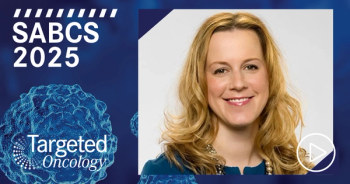
Expanding Allogeneic Stem Cell Transplantation for Relapsed and Refractory Acute Myeloid Leukemia
Allogeneic HCT has shown promise as definitive treatment for patients with relapsed or refractory AML.
The treatment of acute myeloid leukemia (AML) presents a complex puzzle, with a significant fraction of newly diagnosed patients failing to achieve complete remission (CR) even after induction therapy. In this challenging landscape, the role of allogeneic hematopoietic cell transplantation (allo HCT) may be more significant than previously thought. Current guidelines advocate for its use in patients with AML who attain CR but remain at high risk for relapse. However, those who fall short of CR face daunting odds, with a mere 10% survival rate over five years.1-3 Retrospective data show the potential for durable remissions in approximately 30% of refractory or relapsed AML patients post allogeneic HCT. Recent prospective evidence from the phase 3 ASAP trial also suggests that a novel approach involving watchful waiting and sequential conditioning prior to allogeneic HCT might rival salvage chemotherapy, bringing renewed optimism to patients facing poor responses after initial therapy or relapses.4
Emergence of Promise
A recent retrospective analysis by the Acute Leukemia Working Party of the European Society for Blood and Marrow Transplantation (EBMT) shines light on the role of alloHCT in refractory AML. The study by Nagler and colleagues, encompassing 3,430 patients with primary refractory or relapsed AML reveals improving outcomes.5 Of patients treated with allogeneic HCT from unrelated donors between 2000-2009 and 2010 to 2019, 45.5% and 55.5% had refractory AML and 54.5% and 44.5% had relapsed AML, respectively. Despite these high rates of treatment initial treatment resistant disease 2-year overall survival rates were 32.1% and 38.1% respectively, marking a notable improvement over 2 decades. These findings harmonize with previous retrospective examinations of allogeneic HCT's role in refractory or relapsed AML cases. As the landscape evolves, the spotlight shifts to the utilization of HLA-mismatched related and unrelated donors, allowing for new therapeutic options for patients who were previously excluded because of limited graft sources.
Precision in Practice
Acknowledging the diversity inherent in refractory or relapsed AML, researchers have tried to identify variables that can predict favorable outcomes. Duval and colleagues6 using data available through the Center for International Blood and Marrow Transplant Research (CIBMTR) database, identified a set of adverse risk factors: the presence of circulating blasts, a mismatched unrelated donor, a related donor other than an HLA-matched siblings, a Karnofsky score below 90%, and poor-risk cytogenetics. This led to the development of the “Duval Score,” a prognostic system that offers risk stratification for patients with residual or refractory. Patients boasting a score of 0 revel in a 3-year overall survival rate of 42%, while those with a score exceeding 3 drop to a mere 6%. Building upon this foundation, our own pursuit of novel risk factors has recently been presented at the 64th American Society of Hematology Annual Meeting to determine if other variables impact outcomes.
A Shifting Paradigm
The potential of watchful waiting and sequential conditioning is highlighted thanks to the phase 3 randomized trial (NCT02461537). Conducted by Stelljes and colleagues and presented at the 64th American Society of Hematology (ASH) Annual Meeting, this trial challenges conventional wisdom.4 It demonstrated that AML patients with inadequate responses to initial therapy or those who develop relapse derive comparable benefits from watchful waiting and sequential conditioning before allogeneic HCT than intensive chemotherapy. This finding casts doubt on the conventional wisdom of needing salvage chemotherapy with high-dose cytarabine plus anthracycline, offering a transformative shift in the management of refractory or relapsed AML.
Envisioning Tomorrow
The future treatment of relapsed and refractory disease will potentially integrate novel agents and emphasize early HLA-typing to integrate alloHCT early. New agents such as briquilimab or 131I-apamistamab, engineered donor grafts and maintenance therapies could reshape how we control disease and improve disease-free survival and overall well-being among refractory or relapsed AML patients.
The Path Forward
Allogeneic HCT has shown promise as definitive treatment for patients with relapsed or refractory AML. It is best considered in the context of a clinical trial and in conjunction with novel therapies if possible. Continuing to define which patients would derive the most benefit from transplant in this context requires updated prognostic systems that consider enhanced molecular and cytogenetic data and reflect the changes in standard of care for patients with acute leukemia.
REFERENCES
1. Forman SJ, Rowe JM. The myth of the second remission of acute leukemia in the adult. Blood. 2013;121(7):1077-1082.
2. Ganzel C, Sun Z, Cripe LD, et al. Very poor long-term survival in past and more recent studies for relapsed AML patients: The ECOG-ACRIN experience. Am J Hematol. 2018;93(8):1074-1081.
3. Roboz GJ, Rosenblat T, Arellano M, et al. International randomized phase III study of elacytarabine versus investigator choice in patients with relapsed/refractory acute myeloid leukemia. J Clin Oncol. 2014;32(18):1919-1926.
4. Stelljes M, Middeke JM, Bug G, et al. In patients with relapsed/refractory aml sequential conditioning and immediate allogeneic stem cell transplantation (allo-hct) results in similar overall and leukemia-free survival compared to intensive remission induction chemotherapy followed by allo-hct: results from the randomized phase III ASAP trial. Blood. 2002. 140(suppl 1): 9–11. doi: 10.1182/blood-2022-159962
5. Nagler A, Ngoya M, Galimard JE, et al. Longitudinal Outcome over Two Decades of Unrelated Allogeneic Stem Cell Transplantation for Relapsed/Refractory Acute Myeloid Leukemia: An ALWP/EBMT Analysis. Clin Cancer Res. 2022;28(19):4258-4266. doi:10.1158/1078-0432.CCR-22-0809
6. Duval M, Klein JP, He W, et al. Hematopoietic stem-cell transplantation for acute leukemia in relapse or primary induction failure. J Clin Oncol. 2010;28(23):3730-3738.








































